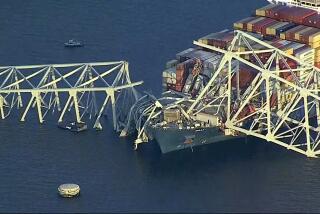Cerebral Contest of Guts, Glory Unfolds in Anaheim
- Share via
Kibitzer--a person who watches a game from the sidelines
--from the American Contract
Bridge League’s “Easy Guide
to Duplicate Bridge.”
An outsider kibitzing the opening of the 1987 Fall North American Bridge Championships at the Anaheim Hilton this week might begin to question the stereotype of bridge players: Bored housewives and milquetoast men who use an arcane card game as an excuse to gossip about what’s happening on “Days of Our Lives.”
And, if doubt remains, any of the 7,500 or so bridge players expected to attend the 10-day tournament will set the outsider straight in nothing flat: Tournament bridge is a contest of guts and glory, so cutthroat--in its cerebral way--that a top-flight player would bite off Rambo’s trigger finger if he got in the way of winning a championship.
Furthermore, the action that unfolds on tables at a big tournament is at least as gripping as a World Series or Super Bowl.
Take the World Team Championship a couple years ago in Sao Paulo, Brazil: The way American Contract Bridge League president Bobby Wolff tells it, kibitzing bridge is what Brazilians do when soccer riots lose their thrill.
In Sao Paulo, fans rocked the observation room with shouts of “Bra-zil! Bra-zil!” he said. “My wife was down there, and she started crying there was so much electricity in the air.”
Of course, to experience the full excitement of kibitzing top-flight bridge it’s necessary to understand the game, and the 186,000-member league is currently on a crusade to round up new players.
What the league promoters neglect to tell prospective recruits is that their little game is incomprehensible. At the tournament, for instance, organizers handed out a pamphlet called the “Easy Guide to Duplicate Bridge,” never bothering to explain that the title is a malicious contradiction in terms.
“The problem for beginners is you have to learn about a dozen things all at once,” said Alfred Sheinwold, whose bridge column appears in about 200 papers, including The Times.
Sheinwold was the chief of cryptographic security with the Defense Department’s Office of Strategic Services in World War II, which would tend to confirm the suspicions of any non-player that newspaper bridge columns, with all those little North, South, East, West diagrams of card suits and numbers, are in fact a complex code that the CIA uses to communicate with KGB double agents.
‘Puzzle Solving’
“Bridge is a game of puzzle solving, quick decisions, concentration and discipline, in which two people playing as partners try to outscore another pair of partners,” Sheinwold said. “Anyone who has played any card game can pick up gin rummy in about 15 minutes. But with bridge you usually need two or three sessions of about two hours just to learn the motions--and then a lifetime to really learn the game.”
Still, 12,000,000 North Americans have persuaded themselves they understand the game well enough to play social, or “rubber” bridge according to league literature. And a small percentage of these people eventually move up to tournament, or duplicate bridge (so-called because all pairs of players must contend with identical, “duplicate,” deals of the cards, thereby reducing the element of luck).
The 10-day tournament in Anaheim features nine title events, leading up to the Reisinger Teams competition. Scheduled for next Friday, Saturday and Sunday, the Reisinger is one of four North American contests leading to a playoff that determines who will represent North America in the World Bridge Federation championships--the next of which will be held October, 1988, in Venice, Italy.
At the preliminary events held last Friday and Saturday, pairs of players squared off against each other for 3 1/2-hour, 26-hand sessions. Gambling is forbidden at tournaments, so all that was at stake were egos and the closely-related “master points,” which a serious player collects aggressively.
Sustaining themselves with 16-ounce cups of coffee and chili dogs, hundreds of casually dressed life masters--players who have accumulated 300 or more points--squared off for the first long rounds of competition. Young caddies dashed between the closely spaced chairs, delivering score-cards to officials who fed the results into computers. Tournament directors hurried about answering questions and settling disputes.
At the beginning of each tournament session, organizers pass out computer-generated lists of hands to players, who then sort the cards and insert them into plastic “boards.” The boards are then passed to another table of players, at which they are dealt. An elaborate rotation ritual assures that players don’t play the board they put together.
At the Reisinger event, things will get even more serious, organizers said. In 1929, Myrtle Bennett riddled her husband with bullets after she “became infuriated” at the way he played a hand, according to the Official Encyclopedia of Bridge.
Perhaps it makes sense, then, to assume that some players might be tempted to behave less than honorably at tournaments.
Thus, boards for the Reisinger competition were duplicated back at league headquarters in Memphis and have been kept under lock and key. And to keep partners from communicating with secret signals, screens will be set diagonally across the tables. Kibitzers will kibitz from a special room, watching on “videographs” that show each player’s hand while experts provide the onlookers with play-by-play commentary.
For the most part, though, bridge players are a breed that relishes intellectual competition for its own sake, and enjoys socializing--and the resulting high-level social connections--the game provides, observers said.
“Lawyers are very good. Computer programmers. Options traders--a surprising number of world class players are options traders,” said Sheinwold, as he autographed score-cards after a lecture Saturday.
“Most people consider the average bridge player a super-intellect . . . very bright, able to jump tall buildings,” said Wolff, who is himself one of the top-rated players in the world.
“The truth of the matter is, for a top bridge player, it’s a particular brand of intelligence, not a general brand of intelligence. Some of the smartest people in the world have been horrible bridge players.”
Math ability is the first quality a top bridge player must have, Wolff said. “That means being able to add to 13, keeping numbers constantly in your mind--all combinations of 13: five, five, two, one; six, four, three, zero; four, four, three, two. . . . You get in the habit of thinking of 13.
“You also have to be well-versed in the theory of games, of what you’re trying to accomplish on any particular hand.” And a solid knowledge of psychology and logic is essential, he said.
“Chess is 100% analytical,” Wolff added dismissively. “It requires concentration, but it’s a mathematical game where there’s always a best play. In bridge, sometimes the second-best play or the fifth-best play is the right one to take against the opponent you’re playing with, for psychological reasons.”
Top-flight players must also have “total dedication and concentration,” he said.
Wolff likened it to the quarterback in football who, “if he loses his concentration, the other side’s got a touchdown. In bridge, at the higher levels, if you lose your concentration, you are liable to commit the error that’s going to cost the tournament.”
Furthering the football analogy, “Strength and endurance are important,” Wolff said, “because you’ve got to play from noon until midnight and maintain that concentration, which is as wearing as any kind of physical activity.”
With few exceptions, the creme de la creme --which would include superstars such as Bob Hamman, Paul Soloway and Zia Mahmoud--devote huge chunks of their lives to bridge.
By hiring themselves out as tournament partners--for as much as $500 a session--and by teaching or writing books and columns and endorsing products, a handful of pros can earn between $100,000 and $200,000 or so a year, several experts said.
How-to Books
That commercial potential was reflected in the tables of paraphernalia at the tournament, including more than 250 different how-to books and novels such as “The Ace of Spys”--which intersperses diagrams of bridge hands into the thriller plot--bridge coffee mugs and paper plates, bridge jewelry, applications for Bridge League Visa cards and a variety of bumper stickers (“Bridge Players Turn More Tricks,” etc.).
And the appetite of the crowd for bridge stuff and bridge games seemed insatiable.
By 1:30 Saturday morning, after two full sessions of competition on Friday, some players milled about, gazing through their bulletproof bifocals with “Night of the Living Dead” stares. Others verbally replayed hands that they’d held hours earlier, and a few hundred sat at card tables playing yet another session.
Meanwhile, Sue Emery and Henry Francis sat at word processors in a little conference room, pounding out the “Daily Bulletin” of tournament news, exceptional hands and session results.
Bridge “occupies the mind of some experts to an amazing extent,” Francis said. “It becomes almost a compulsion.” Days after a game, top players can visualize every card in each of the 26 hands they played in an event.
“It’s not trying to remember ‘em that’s hard--it’s trying to forget them,” said Emery. “Sometimes you’ll lay awake after a tournament, and you just can’t get them out of your mind.”
This intense commitment tends to make the bridge community rather cliquish, players said. Unlike other snobbish groups, however, the bridge community does not have a derogatory term for outsiders.
Smiling only slightly, Sheinwold explained: “We don’t bother to have terms for them because we simply ignore their existence.”
More to Read
Go beyond the scoreboard
Get the latest on L.A.'s teams in the daily Sports Report newsletter.
You may occasionally receive promotional content from the Los Angeles Times.










